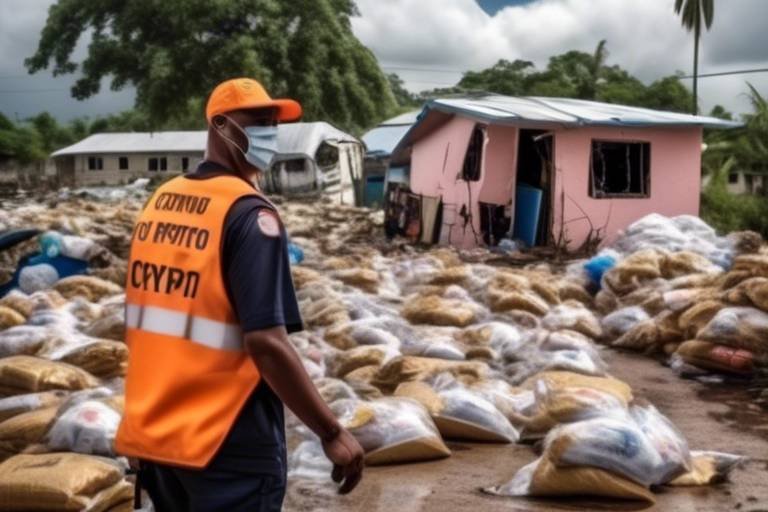The Role of Crypto in Disaster Relief and Recovery
In a world where natural disasters can strike at any moment, the need for **effective** and **efficient** disaster relief has never been more crucial. Traditional methods of aid distribution often face delays and inefficiencies, leaving affected communities in dire situations. This is where cryptocurrency comes into play, offering a revolutionary approach to disaster relief and recovery efforts. By leveraging the power of digital currencies and blockchain technology, organizations can transform the way they respond to crises, ensuring that help reaches those in need faster and more transparently than ever before.
Imagine a scenario where a devastating earthquake strikes a region. In the aftermath, countless individuals are left without basic necessities, and relief organizations scramble to mobilize resources. With cryptocurrency, funds can be transferred almost instantaneously, enabling organizations to purchase supplies and deliver aid without the typical bottlenecks associated with traditional banking systems. This speed of transactions is not just a luxury; it can be the difference between life and death in critical situations.
Moreover, one of the standout features of cryptocurrency is its ability to minimize transaction costs. Traditional banking systems often impose hefty fees for international transfers, which can significantly diminish the amount of aid that actually reaches those in need. By utilizing cryptocurrencies, organizations can ensure that a larger portion of donations is allocated directly to relief efforts, rather than being siphoned off by administrative costs. This efficiency can lead to more funds being available for essential services such as food, water, and medical care.
But the advantages of cryptocurrency in disaster relief extend beyond just speed and cost. The **transparency** offered by blockchain technology allows for real-time tracking of funds, ensuring that donors can see exactly where their contributions are going. This level of accountability can foster greater trust between donors and organizations, encouraging more people to contribute to relief efforts. In an age where skepticism about charitable organizations is prevalent, this transparency could be a game changer.
However, it's important to acknowledge that the integration of cryptocurrency into disaster relief is not without its challenges. Regulatory hurdles can complicate the deployment of crypto solutions, as governments around the world grapple with how to manage and oversee these digital assets. Additionally, the inherent volatility of cryptocurrencies poses risks for relief organizations that rely on these assets. A sudden drop in value could jeopardize the funds intended for aid, making it essential for organizations to develop strategies to mitigate these risks.
As we explore the potential of cryptocurrency in disaster relief, it's vital to look at real-world applications that showcase its effectiveness. Numerous organizations have already begun to utilize crypto in their disaster response efforts, demonstrating the technology's ability to facilitate rapid recovery. From hurricane relief to earthquake recovery initiatives, the success stories are emerging, providing valuable insights into how cryptocurrency can reshape the landscape of humanitarian aid.
In conclusion, the role of cryptocurrency in disaster relief and recovery is one filled with **promise** and **potential**. As technology continues to evolve, so too will the applications of cryptocurrency in this vital sector. Innovative solutions are on the horizon, and with the right partnerships and trust-building measures in place, we can look forward to a future where aid is delivered more effectively and efficiently than ever before. The journey has just begun, and the impact of crypto on disaster relief could very well redefine how we respond to crises globally.
- What is cryptocurrency? Cryptocurrency is a digital or virtual currency that uses cryptography for security and operates on a technology called blockchain.
- How does cryptocurrency aid disaster relief? Cryptocurrency enables rapid fund transfers, reduces transaction costs, and enhances transparency in the distribution of aid.
- What are the challenges of using cryptocurrency for disaster relief? Key challenges include regulatory hurdles, price volatility, and the need for technological infrastructure in affected areas.
- Can cryptocurrency be trusted in disaster situations? With proper measures in place, such as blockchain transparency, trust can be established among stakeholders involved in relief efforts.

Understanding Cryptocurrency Basics
Before we dive into the fascinating world of cryptocurrency and its potential to revolutionize disaster relief, let's take a moment to understand what cryptocurrency actually is. At its core, cryptocurrency is a form of digital or virtual currency that uses cryptography for security. Unlike traditional currencies issued by governments, cryptocurrencies operate on decentralized networks based on blockchain technology. This means that transactions are recorded across multiple computers, making it nearly impossible to manipulate or counterfeit.
One of the most well-known cryptocurrencies is Bitcoin, which was created in 2009. Since then, thousands of alternative cryptocurrencies, often called altcoins, have emerged. These currencies can vary significantly in terms of their technology, purpose, and market value. For instance, while Bitcoin is often viewed as a digital gold, others like Ethereum are designed to facilitate smart contracts and decentralized applications.
To better understand how cryptocurrencies work, here are some key components:
- Decentralization: Unlike traditional banking systems, cryptocurrencies are not controlled by a central authority. This decentralization can enhance security and reduce the risk of corruption.
- Blockchain: This is the underlying technology that powers cryptocurrencies. It functions as a public ledger that records all transactions in a secure and transparent manner.
- Wallets: To store and manage cryptocurrencies, users need digital wallets. These can be software-based or hardware devices that hold the private keys necessary to access and manage their crypto assets.
- Mining: Some cryptocurrencies, like Bitcoin, require a process called mining, where powerful computers solve complex mathematical problems to validate transactions and create new coins.
Understanding these basics is crucial as we explore how cryptocurrency can be leveraged in disaster relief efforts. The unique features of cryptocurrencies, such as their ability to facilitate quick transactions and reach unbanked populations, make them particularly suitable for urgent humanitarian needs. As we continue, keep in mind how these elements come together to create a powerful tool for change in the face of crises.

Benefits of Using Cryptocurrency in Disaster Relief
When disaster strikes, the clock is ticking, and every second counts. In such critical situations, the efficiency of fund transfers and the ability to reach those in need can make all the difference. Cryptocurrency emerges as a game changer, offering a plethora of advantages that traditional financial systems often struggle to match. One of the most significant benefits is the speed of transactions. Unlike conventional banking methods that can take days to process, cryptocurrency transactions can be completed in mere minutes. This rapid deployment of funds is crucial when lives are at stake, allowing organizations to mobilize resources and provide immediate assistance to affected communities.
Moreover, the lower transaction costs associated with cryptocurrencies cannot be overlooked. Traditional banking systems often impose hefty fees for international transfers, which can significantly reduce the amount of aid that actually reaches those in need. With cryptocurrencies, these costs are minimized, ensuring that a larger portion of donations goes directly to relief efforts. This means more food, shelter, and medical supplies can be provided without the burden of excessive administrative fees eating into the funds.
Another compelling advantage is the ability of cryptocurrencies to reach unbanked populations. In many disaster-stricken areas, traditional banking infrastructure may be damaged or non-existent, leaving affected individuals without access to financial services. Cryptocurrencies, however, can be accessed through mobile devices, enabling aid organizations to transfer funds directly to those in need, regardless of their banking status. This accessibility is vital in ensuring that help reaches even the most marginalized communities.
Furthermore, the use of cryptocurrency can enhance transparency and accountability in disaster relief efforts. Blockchain technology, which underpins cryptocurrencies, allows for all transactions to be recorded in a public ledger. This means that donors can track where their funds are going and how they are being used, fostering greater trust between aid organizations and the communities they serve. In an age where skepticism towards charitable organizations is common, this transparency can encourage more people to contribute, knowing their donations are being utilized effectively.
In summary, the benefits of using cryptocurrency in disaster relief are multifaceted. From the speed of transactions and reduced costs to the ability to reach unbanked populations and enhance transparency, cryptocurrencies hold the potential to revolutionize how aid is delivered in times of crisis. As we continue to explore these advantages, it becomes clear that integrating cryptocurrency into disaster relief efforts could lead to faster, more effective support for those who need it most.

Speed of Transactions
In the chaotic aftermath of a disaster, every second counts. Imagine being in a situation where a hurricane has just ravaged your community, leaving families stranded and in desperate need of immediate assistance. Traditional banking systems can often be slow to respond, bogged down by lengthy processes and bureaucratic red tape. This is where cryptocurrency shines like a beacon of hope. With cryptocurrency, transactions can occur almost instantly, allowing organizations to mobilize resources and deliver aid without the frustrating delays that can cost lives.
How does this speed work? Well, cryptocurrency operates on a decentralized network, meaning it bypasses the traditional banking infrastructure that can slow things down. Instead of waiting days for funds to clear and be transferred, cryptocurrencies can be sent and received in a matter of minutes. This rapid transaction capability is crucial in disaster relief scenarios, where the ability to act quickly can make all the difference. For example, during the aftermath of a major earthquake, relief organizations can send funds directly to local responders, enabling them to purchase supplies and provide assistance almost immediately.
Furthermore, the speed of transactions also enhances the ability to track and allocate resources effectively. With every transaction recorded on the blockchain, organizations can monitor the flow of funds in real-time. This transparency not only builds trust among donors but also ensures that resources are utilized where they are needed most. In a world where every moment matters, the swift nature of cryptocurrency transactions can be the key to saving lives and rebuilding communities.
To illustrate this point further, consider the following table that compares the average transaction times for traditional banking systems versus cryptocurrencies in disaster scenarios:
| Method | Average Transaction Time |
|---|---|
| Traditional Banking | 1-5 Business Days |
| Cryptocurrency | Minutes |
In conclusion, the speed of cryptocurrency transactions is not just a technical advantage; it is a lifeline during emergencies. By harnessing this technology, disaster relief organizations can ensure that aid reaches those in need without unnecessary delays, ultimately transforming the landscape of humanitarian assistance.
- What is cryptocurrency? Cryptocurrency is a digital or virtual currency that uses cryptography for security and operates on a technology called blockchain.
- How does cryptocurrency help in disaster relief? It allows for rapid fund transfers, lower transaction fees, and the ability to reach unbanked populations, ensuring aid can be delivered promptly.
- Are there risks associated with using cryptocurrency in disaster relief? Yes, there are challenges such as regulatory hurdles and price volatility, which can complicate its use in urgent situations.

Lower Transaction Costs
When it comes to disaster relief, every single dollar counts. Traditional banking systems often impose steep fees for international transfers, which can eat away at the funds meant for those in dire need. Imagine a scenario where a charity raises $100,000 to help victims of a natural disaster, only to find that a significant portion is siphoned off by transaction fees. This is where cryptocurrency shines brightly, offering a beacon of hope in the form of lower transaction costs. With cryptocurrencies, organizations can send funds across borders with minimal fees, ensuring that more of the money raised goes directly to the people who need it the most.
To put this into perspective, let’s consider a comparison of transaction costs between traditional banking and cryptocurrency:
| Method | Average Transaction Fee | Time to Process |
|---|---|---|
| Traditional Banking | 3-7% | 1-5 days |
| Cryptocurrency | 0.5-2% | 10 minutes - 1 hour |
This table illustrates the stark differences in transaction fees and processing times. By utilizing cryptocurrency, organizations can allocate a larger portion of their funds to actual relief efforts rather than letting a chunk disappear into banking fees. This not only enhances the efficiency of aid distribution but also builds a stronger trust among donors who want to see their contributions make a real impact.
Furthermore, the ability to conduct transactions quickly and at a lower cost means that organizations can respond to crises with agility. For instance, if a disaster strikes and funds need to be mobilized immediately, the speed of cryptocurrency transactions allows for rapid deployment of resources. This is not just a matter of convenience; it can literally mean the difference between life and death for those affected by disasters. When every second counts, having a financial system that operates efficiently can save lives.
In conclusion, the lower transaction costs associated with cryptocurrency not only facilitate more effective disaster relief efforts but also empower organizations to maximize the impact of their donations. By reducing the financial burden of transferring funds, cryptocurrencies can help ensure that aid reaches those who need it most, quickly and efficiently.

Challenges of Implementing Cryptocurrency
While the potential of cryptocurrency in disaster relief is undeniably exciting, there are significant challenges that need to be addressed for its successful implementation. One of the primary hurdles is navigating the complex landscape of regulatory issues. Governments and financial institutions across the globe have established strict regulations regarding cryptocurrency transactions. This can complicate the deployment of crypto in disaster relief efforts, potentially delaying the much-needed aid to affected communities. Imagine trying to send help to a disaster-stricken area, only to be held back by red tape and legal constraints. It’s a frustrating reality that many organizations face.
Another major concern is the volatility associated with cryptocurrencies. The value of digital currencies can fluctuate dramatically in a short period, which poses a risk for relief organizations that rely on these assets for funding. For instance, if an organization raises funds in cryptocurrency but the value drops significantly before they can convert it to local currency, the amount available for aid could be severely diminished. This uncertainty can make it difficult for organizations to plan their budgets and allocate resources effectively. To illustrate this point, consider the following table:
| Cryptocurrency | Value Fluctuation (%) | Impact on Relief Fund |
|---|---|---|
| Bitcoin | ±10% | Potential loss of $10,000 on a $100,000 fund |
| Ethereum | ±15% | Potential loss of $15,000 on a $100,000 fund |
Additionally, the need for technological infrastructure in affected areas can pose another barrier. Many disaster-stricken regions may lack reliable internet access or the necessary technology to facilitate cryptocurrency transactions. Without the proper infrastructure, even the most well-intentioned relief efforts can come to a standstill. It’s akin to having a powerful engine but no road to drive on; the potential is there, but without the right conditions, progress is halted.
Despite these challenges, it’s important to recognize that the landscape of cryptocurrency is rapidly evolving. As organizations work to address these issues, they may find innovative solutions that can pave the way for broader adoption in disaster relief. The journey is certainly not without its bumps, but the potential rewards make it a path worth exploring.
In summary, the challenges of implementing cryptocurrency in disaster relief—ranging from regulatory hurdles and volatility to infrastructure limitations—must be addressed to unlock its full potential. Each of these factors plays a critical role in determining how effectively aid can be delivered to those in need. By tackling these challenges head-on, we can create a more efficient and responsive system for disaster relief efforts.
- What are the main benefits of using cryptocurrency in disaster relief?
Cryptocurrency allows for rapid fund transfers, lower transaction costs, and the ability to reach unbanked populations, ensuring that aid reaches those in need promptly. - How does volatility affect disaster relief funding?
Volatility can lead to significant fluctuations in the value of funds raised in cryptocurrency, which can impact the amount available for aid if not managed properly. - What regulatory challenges do organizations face?
Organizations must navigate strict regulations imposed by governments and financial institutions, which can complicate the deployment of cryptocurrency in disaster relief.

Regulatory Hurdles
When it comes to the integration of cryptocurrency into disaster relief efforts, one of the most significant challenges lies in navigating the complex landscape of . Governments around the world have adopted varying stances on cryptocurrency, leading to a patchwork of regulations that can complicate its use in urgent situations. For example, some countries embrace crypto, while others impose strict regulations or outright bans. This inconsistency can create confusion for relief organizations trying to deploy funds quickly and effectively.
Moreover, the legal frameworks surrounding cryptocurrency are often still evolving. Many countries are working to draft regulations that can accommodate the unique characteristics of digital currencies, but until these regulations are in place, organizations may face significant delays in their operations. In a disaster scenario, where every moment counts, regulatory uncertainty can hinder timely assistance. This is particularly concerning when funds raised through cryptocurrencies must be converted into local currencies, as this process often requires compliance with local laws.
Additionally, regulatory bodies may require organizations to adhere to stringent anti-money laundering (AML) and know your customer (KYC) protocols. While these measures are essential for preventing fraud and ensuring transparency, they can also slow down the process of fund distribution. For instance, organizations may need to verify the identities of donors and recipients, which can be a lengthy process, especially in regions where documentation is scarce due to the disaster itself.
To illustrate the impact of regulatory hurdles, consider the following table that outlines some of the key challenges faced by organizations looking to implement cryptocurrency in disaster relief:
| Challenge | Description |
|---|---|
| Inconsistent Regulations | Different countries have varying laws regarding cryptocurrency, leading to confusion and delays. |
| Legal Uncertainty | Evolving regulations can create a lack of clarity on how to operate within legal frameworks. |
| AML and KYC Compliance | Stringent requirements can slow down the distribution of funds, delaying aid to those in need. |
| Currency Conversion Issues | Converting crypto to local currency may require navigating complex regulations, further delaying assistance. |
In conclusion, while cryptocurrency holds immense potential for enhancing disaster relief efforts, it is crucial to address these regulatory hurdles. By fostering dialogue between governments, NGOs, and the cryptocurrency community, we can pave the way for more streamlined processes that ensure aid reaches those in need without unnecessary delays. Only then can we harness the full power of digital currencies to support vulnerable communities during their most challenging times.
- What are the main benefits of using cryptocurrency in disaster relief? Cryptocurrency offers rapid fund transfers, lower transaction costs, and the ability to reach unbanked populations, ensuring that aid gets to those who need it most.
- How do regulatory hurdles affect disaster relief efforts? Regulatory hurdles can delay the deployment of funds, complicate compliance with local laws, and create uncertainty for organizations trying to provide timely assistance.
- What can be done to overcome these regulatory challenges? Open dialogue between stakeholders, including governments and NGOs, can help create clearer guidelines and foster collaboration in the use of cryptocurrency for disaster relief.

Volatility Concerns
When it comes to using cryptocurrency in disaster relief, one of the most significant hurdles is the volatility of these digital assets. Imagine relying on a currency that can swing wildly in value from one day to the next. This uncertainty can create major challenges for relief organizations that need to ensure their funds maintain value to effectively assist those in need. For instance, if an organization raises funds in Bitcoin, and the value drops significantly before they can convert it to local currency, the amount available for aid could be drastically reduced.
Furthermore, this volatility can lead to a lack of confidence among both donors and recipients. Donors might hesitate to contribute if they fear their contributions could lose value, while recipients may be unsure of how much aid they will actually receive when the time comes. This uncertainty can complicate the already challenging logistics of disaster response.
To illustrate this concern, let's take a look at some historical price fluctuations of popular cryptocurrencies:
| Cryptocurrency | Price Change (30 Days) | Price Change (1 Year) |
|---|---|---|
| Bitcoin (BTC) | -10% | +150% |
| Ethereum (ETH) | -15% | +120% |
| Ripple (XRP) | -20% | +80% |
As seen in the table, cryptocurrencies can experience significant price changes in a short period. This unpredictability means that relief organizations must have robust strategies in place to mitigate these risks. Some organizations are exploring the use of stablecoins—cryptocurrencies designed to maintain a stable value pegged to traditional currencies—as a way to provide more predictability in their funding.
Ultimately, addressing the issue of volatility is crucial for enhancing the effectiveness of cryptocurrency in disaster relief efforts. Building a framework that includes risk management strategies, real-time monitoring of market conditions, and perhaps even insurance mechanisms could offer a way forward. By tackling these volatility concerns, we can ensure that cryptocurrencies can be a reliable tool in the humanitarian toolbox, enabling quicker and more effective responses to disasters when they strike.
- What is cryptocurrency volatility? Cryptocurrency volatility refers to the rapid and unpredictable price fluctuations that can occur within the cryptocurrency market.
- How does volatility affect disaster relief? Volatility can undermine the reliability of funds raised for disaster relief, potentially reducing the amount of aid available when it is most needed.
- What are stablecoins? Stablecoins are a type of cryptocurrency designed to maintain a stable value by being pegged to traditional currencies or other assets.
- Can organizations mitigate volatility risks? Yes, organizations can employ strategies such as using stablecoins, real-time market monitoring, and risk management frameworks to mitigate the impact of volatility.

Case Studies of Crypto in Action
Examining real-world examples of cryptocurrency use in disaster relief offers a fascinating glimpse into how this technology can effectively assist communities in crisis. One notable case occurred after the devastating hurricanes that struck the Caribbean and the southeastern United States. Organizations such as Binance Charity leveraged cryptocurrency to raise funds for immediate relief efforts. By accepting donations in various cryptocurrencies, they were able to mobilize resources quickly, allowing them to provide food, shelter, and medical assistance to those affected. The speed of transactions enabled these organizations to bypass traditional banking delays, ensuring that aid reached victims in a matter of hours rather than days.
Another compelling example comes from the aftermath of significant earthquakes, particularly the 2010 Haiti earthquake. Various NGOs, including Red Cross, began to accept Bitcoin donations to streamline the flow of funds. This approach not only made it easier for international donors to contribute but also helped to reduce transaction fees associated with traditional banking methods. As a result, a larger portion of the funds raised went directly to relief efforts. The transparency of blockchain technology allowed donors to track their contributions, giving them confidence that their money was being used effectively.
In both scenarios, the use of cryptocurrency highlighted several key benefits:
- Rapid Fund Mobilization: Cryptocurrency transactions can be completed almost instantly, which is critical in emergency situations.
- Lower Costs: By reducing transaction fees, more funds can be allocated directly to those in need.
- Increased Transparency: Blockchain technology provides a clear record of transactions, fostering trust among donors and organizations.
However, these cases also revealed some challenges. For instance, while many people were eager to donate in cryptocurrency, there was often a lack of understanding about how to do so. This led organizations to invest in educational campaigns to inform potential donors about the benefits and processes of cryptocurrency donations. Furthermore, the volatility of cryptocurrencies posed a risk; organizations had to manage the timing of converting crypto donations into stable currencies to ensure that the funds could be used effectively.
Overall, these case studies demonstrate that while cryptocurrency is not without its challenges, its application in disaster relief has shown significant promise. As more organizations begin to embrace this technology, we can expect to see further innovations and improvements in the way aid is delivered to those in need.
- How does cryptocurrency help in disaster relief?
Cryptocurrency facilitates rapid fund transfers, reduces transaction costs, and allows for greater transparency in aid distribution. - What are the risks associated with using cryptocurrency for donations?
Volatility in cryptocurrency prices can affect the amount of aid available, and regulatory hurdles can complicate the donation process. - Can anyone donate cryptocurrency to disaster relief efforts?
Yes, many organizations accept cryptocurrency donations, but it's essential to understand how to make these donations securely. - What are some successful examples of cryptocurrency in disaster relief?
Examples include the use of Bitcoin donations by the Red Cross after the Haiti earthquake and Binance Charity's efforts post-hurricanes.

Hurricane Relief Efforts
When hurricanes strike, they leave behind a trail of devastation that affects countless lives. In these critical moments, the speed and efficiency of relief efforts can mean the difference between life and death. Cryptocurrency has emerged as a powerful tool in these situations, showcasing its potential to revolutionize how aid is distributed. For instance, during Hurricane Harvey in 2017, various organizations turned to digital currencies to facilitate donations and expedite the flow of funds directly to affected communities.
One of the most remarkable aspects of using cryptocurrency in hurricane relief efforts is the ability to bypass traditional banking systems. Many people in disaster-stricken areas may not have access to conventional banking services, which can delay the distribution of aid. By utilizing cryptocurrencies, organizations can reach these unbanked populations directly, ensuring that help arrives swiftly. Imagine a family stranded in their home, waiting for assistance; with cryptocurrency, they can receive funds almost instantly, allowing them to purchase food, water, and other essential supplies.
Additionally, the transparency offered by blockchain technology is a game-changer. Every transaction made with cryptocurrency is recorded on a public ledger, which means that donors can track where their contributions are going. This level of transparency builds trust among stakeholders and encourages more people to donate, knowing their funds are being used effectively. For example, after Hurricane Maria hit Puerto Rico, several organizations leveraged blockchain to provide real-time updates on how donations were being utilized, fostering a sense of accountability.
However, it's important to note that while cryptocurrency has shown promise, it is not without its challenges. The volatility of digital currencies can pose risks; for instance, a donation made today could lose value by the time it reaches those in need. Relief organizations must develop strategies to mitigate these risks, such as converting donations into stablecoins—cryptocurrencies designed to maintain a stable value. This approach can help ensure that funds retain their purchasing power, allowing for more effective aid distribution.
In summary, the use of cryptocurrency in hurricane relief efforts is not just a trend; it represents a shift towards more efficient, transparent, and accessible aid. As we continue to explore the potential of digital currencies in disaster recovery, it's clear that they can play a crucial role in transforming how we respond to natural disasters. The future holds exciting possibilities, and with the right strategies in place, we can harness the power of cryptocurrency to improve the lives of those affected by hurricanes and other calamities.
- How does cryptocurrency help in disaster relief? Cryptocurrency facilitates rapid fund transfers, reduces transaction fees, and allows aid to reach unbanked populations.
- What are the risks associated with using cryptocurrency for relief efforts? The main risks include regulatory hurdles and the volatility of cryptocurrencies, which can affect the value of donations.
- Can cryptocurrency be converted into local currency? Yes, many organizations convert cryptocurrency donations into local currencies to ensure aid can be used effectively.

Earthquake Recovery Initiatives
In the chaotic aftermath of an earthquake, the need for immediate financial assistance is paramount. Traditional methods of fundraising and aid distribution often struggle to keep pace with the urgency of the situation. This is where cryptocurrency steps in as a revolutionary tool, enabling organizations to streamline donations and direct funds to those in need with unprecedented speed and efficiency. For instance, during the devastating earthquake in Haiti in 2010, several NGOs turned to cryptocurrency to facilitate donations from around the globe. The result? A surge in funding that was both swift and effective, allowing for rapid deployment of resources to the affected areas.
One of the standout features of cryptocurrency in this context is its ability to reach individuals who are often cut off from traditional banking systems. In many earthquake-stricken regions, local banks may be damaged or non-functional, leaving residents without access to cash or financial services. Cryptocurrencies, however, can be accessed via smartphones and the internet, providing a lifeline to those who need it most. This accessibility is crucial in ensuring that aid reaches the most vulnerable populations, allowing them to rebuild their lives without unnecessary delays.
Moreover, the transparency provided by blockchain technology offers a significant advantage in managing donations. Every transaction is recorded on an immutable ledger, which means that donors can track where their contributions go. This level of transparency builds trust between donors and organizations, as they can see the direct impact of their support. For example, during the recovery efforts in Nepal after the 2015 earthquake, many organizations utilized blockchain to ensure that funds were allocated efficiently and effectively, minimizing corruption and mismanagement.
However, the implementation of cryptocurrency in earthquake recovery is not without its challenges. Regulatory hurdles can complicate the process, as governments may be hesitant to embrace this new technology. Additionally, the volatility of cryptocurrencies can pose risks for organizations that rely on these assets for their operations. To mitigate these concerns, it is essential for organizations to develop strategies for managing volatility, such as converting donations into stablecoins or fiat currencies as soon as they are received.
As we look to the future, the potential for cryptocurrency in earthquake recovery initiatives is vast. Emerging technologies and partnerships are paving the way for innovative solutions that can enhance the effectiveness of humanitarian efforts. By building trust among stakeholders, including governments, NGOs, and local communities, we can create a collaborative environment where cryptocurrency can thrive as a tool for disaster relief. Ultimately, the goal is to ensure that when the earth shakes, help is not just on the way—it’s already there, ready to make a difference.
- How does cryptocurrency help in disaster relief? Cryptocurrency enables rapid fund transfers, reduces transaction fees, and reaches unbanked populations, ensuring that aid is delivered quickly and effectively.
- What are the risks associated with using cryptocurrency in disaster recovery? The primary risks include regulatory hurdles, price volatility, and the need for technological infrastructure in affected areas.
- Can cryptocurrency be tracked in disaster relief efforts? Yes, blockchain technology allows for transparent tracking of transactions, which helps build trust between donors and organizations.
- Are there successful examples of cryptocurrency use in earthquake recovery? Yes, initiatives in Haiti and Nepal have demonstrated the effectiveness of cryptocurrency in facilitating rapid financial assistance during and after earthquakes.

Future Potential of Crypto in Disaster Recovery
The future of cryptocurrency in disaster recovery is not just a fleeting trend; it holds the potential to revolutionize how aid is delivered and managed in times of crisis. As technology continues to evolve, we are witnessing a shift towards more innovative solutions that leverage the strengths of cryptocurrencies and blockchain technology. Imagine a world where aid can be distributed instantly, transparently, and securely, reaching the hands of those who need it most without the usual bureaucratic delays. This is not just a dream; it is becoming a reality.
One of the most exciting aspects of this evolution is the emergence of decentralized finance (DeFi) applications that can facilitate peer-to-peer transactions without the need for intermediaries. In a disaster scenario, this means that donations can flow directly from donors to recipients, minimizing the risk of funds being lost or mismanaged. Furthermore, smart contracts can automate the distribution of funds based on predefined conditions, ensuring that aid is released when it is needed most. For instance, if a certain threshold of funds is reached, the smart contract could automatically trigger the release of aid to affected communities.
Moreover, the integration of blockchain technology can enhance transparency in disaster relief efforts. Each transaction is recorded on a public ledger, allowing stakeholders to track how funds are being utilized. This level of transparency not only builds trust among donors but also ensures that funds are spent effectively. As we have seen in various case studies, the ability to monitor transactions in real-time can lead to more informed decision-making and better allocation of resources.
However, the future is not without its challenges. Building trust among stakeholders is crucial for the successful integration of cryptocurrency into disaster relief. Governments, NGOs, and communities must collaborate to create a framework that supports the use of crypto while addressing regulatory concerns. This could involve developing guidelines that ensure compliance with existing laws while promoting innovation. Additionally, educational initiatives are essential to familiarize all parties with the benefits and risks associated with cryptocurrency.
As we look ahead, the potential for innovative partnerships is vast. Collaborations between tech companies, humanitarian organizations, and financial institutions can lead to groundbreaking solutions that enhance the overall effectiveness of disaster recovery efforts. For example, partnerships could focus on developing mobile applications that allow individuals in disaster-stricken areas to receive and spend cryptocurrency effortlessly, thereby improving their access to essential services.
In conclusion, the future of cryptocurrency in disaster recovery is promising, filled with opportunities to improve the speed, efficiency, and transparency of aid distribution. As we continue to explore its potential, it is vital to remain proactive in addressing the challenges that may arise. By fostering collaboration and building trust among all stakeholders, we can pave the way for a more resilient and responsive disaster relief system.
- What are the main advantages of using cryptocurrency in disaster relief?
Cryptocurrency allows for rapid fund transfers, lower transaction costs, and the ability to reach unbanked populations, ensuring aid reaches those in need promptly.
- How does blockchain technology enhance transparency in disaster relief?
Blockchain records every transaction on a public ledger, allowing stakeholders to track the flow of funds and ensuring accountability in how aid is utilized.
- What challenges does cryptocurrency face in disaster recovery?
Challenges include regulatory hurdles, price volatility, and the need for technological infrastructure in affected areas.
- Can cryptocurrency be used in all disaster scenarios?
While it has great potential, the effectiveness of cryptocurrency in disaster relief can vary depending on the local context, including technological readiness and regulatory environment.

Innovative Solutions on the Horizon
As we look towards the future, the integration of cryptocurrency in disaster relief is poised for remarkable advancements. The rapid evolution of technology, particularly in the realm of blockchain, is setting the stage for innovative solutions that can revolutionize humanitarian efforts. Imagine a world where aid can be deployed at the speed of light, where every transaction is not only swift but also transparent and traceable. This is not just a dream; it is becoming a reality thanks to ongoing developments in the crypto space.
One of the most exciting prospects is the emergence of decentralized finance (DeFi) platforms that could facilitate peer-to-peer donations without the need for intermediaries. This direct approach can drastically reduce the time it takes for funds to reach those in need. Furthermore, smart contracts—self-executing contracts with the terms of the agreement directly written into code—can automate the distribution of aid based on predefined criteria. For instance, when certain conditions are met, such as a natural disaster being declared, funds can be automatically released to designated relief organizations.
Additionally, partnerships between tech companies and humanitarian organizations are likely to yield new applications and tools. These collaborations can lead to the development of mobile apps that allow individuals to donate cryptocurrency easily while tracking how their contributions are being utilized. Such transparency not only builds trust but also encourages more people to participate in relief efforts. Further, initiatives focusing on educating communities about cryptocurrency can empower them to manage their own funds more effectively, ensuring that aid is not just a temporary fix but a step towards long-term recovery.
Moreover, the potential for integrating artificial intelligence (AI) with blockchain technology could enhance decision-making processes in disaster response. AI can analyze vast amounts of data to predict where disasters might strike next, allowing organizations to preemptively allocate resources. This proactive approach could be a game-changer, shifting disaster relief from a reactive to a more strategic model.
In summary, the horizon is bright for innovative solutions in the realm of cryptocurrency and disaster relief. As technology continues to advance, we can anticipate a future where aid is not only faster and more efficient but also more equitable. The key will be to foster collaboration among stakeholders, ensuring that these innovations are accessible and beneficial to the communities that need them the most.
- What is cryptocurrency? Cryptocurrency is a digital or virtual currency that uses cryptography for security and operates on a technology called blockchain.
- How can cryptocurrency help in disaster relief? It offers rapid fund transfers, lower transaction costs, and the ability to reach unbanked populations, ensuring aid reaches those in need quickly.
- What are the challenges of using cryptocurrency in disaster relief? Challenges include regulatory hurdles, price volatility, and the need for technological infrastructure in affected areas.
- Are there examples of cryptocurrency being used in disaster relief? Yes, notable examples include fundraising for hurricane relief and providing financial assistance after earthquakes.
- What innovations can we expect in the future? Innovations may include decentralized finance platforms, smart contracts for automated aid distribution, and AI integration for predictive analysis in disaster response.

Building Trust with Stakeholders
In the realm of disaster relief, trust is paramount. It's the glue that holds together the intricate web of relationships among stakeholders, including governments, non-governmental organizations (NGOs), and the communities they serve. When it comes to implementing cryptocurrency in these efforts, establishing trust becomes even more critical. Why? Because cryptocurrency, while revolutionary, is still a relatively new concept for many. Stakeholders need to feel confident that their investments in this technology will yield positive outcomes.
One of the most effective ways to build trust is through transparency. By openly sharing how funds are raised, distributed, and utilized, organizations can demonstrate their commitment to accountability. For instance, using blockchain technology allows for real-time tracking of donations, making it easy for stakeholders to see the impact of their contributions. Imagine a scenario where a donor can view exactly how their funds are being used to help a community recover from a natural disaster. This level of transparency can significantly enhance trust and encourage further donations.
Moreover, engaging in collaborative partnerships can also foster trust among stakeholders. When organizations work together, pooling resources and expertise, they can create a unified front that reassures communities and donors alike. For example, a partnership between a local NGO and a tech company specializing in cryptocurrency could lead to innovative solutions that streamline aid distribution. This collaboration not only enhances operational efficiency but also signals to stakeholders that the initiative is backed by credible entities.
Additionally, education plays a vital role in building trust. Many stakeholders may have misconceptions about cryptocurrency, viewing it as risky or unregulated. By providing clear, accessible information about how cryptocurrency works and its benefits in disaster relief, organizations can alleviate fears and encourage acceptance. Workshops, webinars, and informational materials can be effective tools for this purpose. For example:
- Host community workshops to explain how cryptocurrency can expedite aid.
- Create informative brochures that outline the security measures in place.
- Utilize social media platforms to share success stories and testimonials from beneficiaries.
Finally, it’s essential to cultivate a culture of feedback and responsiveness. Stakeholders should feel that their voices are heard and valued. Regularly soliciting feedback through surveys or community meetings can provide valuable insights into how the initiative is perceived and what improvements can be made. When stakeholders see that their input leads to tangible changes, their trust in the system deepens. It's a virtuous cycle where trust leads to collaboration, and collaboration, in turn, builds even more trust.
In conclusion, building trust with stakeholders in the context of cryptocurrency and disaster relief is not just about implementing technology; it's about forging meaningful relationships. By prioritizing transparency, fostering collaboration, educating stakeholders, and embracing feedback, organizations can create an environment where trust flourishes. This foundation is crucial as we move forward into a future where cryptocurrency could play a transformative role in disaster recovery efforts.
- What is cryptocurrency? Cryptocurrency is a digital or virtual currency that uses cryptography for security and operates on a technology called blockchain.
- How does cryptocurrency help in disaster relief? It enables rapid fund transfers, reduces transaction costs, and can reach unbanked populations more effectively.
- What are the risks associated with using cryptocurrency? The main risks include regulatory hurdles, price volatility, and the need for technological infrastructure in affected areas.
- How can organizations ensure transparency in cryptocurrency transactions? By utilizing blockchain technology, organizations can provide real-time tracking of donations and expenditures.
- What role do partnerships play in building trust? Collaborative efforts among NGOs, governments, and tech companies can enhance credibility and operational efficiency.
Frequently Asked Questions
- What is cryptocurrency and how does it work?
Cryptocurrency is a digital or virtual currency that uses cryptography for security. It operates on a technology called blockchain, which is a decentralized ledger that records all transactions across a network of computers. This ensures that transactions are secure, transparent, and cannot be altered. Think of it as a digital handshake that verifies and records every deal made without the need for a middleman.
- How can cryptocurrency improve disaster relief efforts?
Cryptocurrency can significantly enhance disaster relief by enabling rapid fund transfers, reducing transaction fees, and providing access to unbanked populations. In emergencies, every second counts, and crypto transactions can be completed almost instantly, ensuring that aid reaches those in need without unnecessary delays. Imagine being able to send help directly to someone in need with just a few clicks!
- What are the main challenges of using cryptocurrency in disaster relief?
While the potential is vast, there are challenges to consider. Regulatory hurdles can complicate the use of crypto, as many governments have strict rules regarding its use. Additionally, the volatility of cryptocurrencies can pose risks, as their value can fluctuate wildly. It's like trying to catch a slippery fish; you need to be careful and strategic to hold on to it!
- Can you provide examples of cryptocurrency used in disaster recovery?
Absolutely! There have been several notable instances where cryptocurrency played a crucial role in disaster recovery. For example, after hurricanes, organizations have successfully raised funds using crypto to provide immediate aid. Similarly, in earthquake recovery efforts, crypto has streamlined donations, allowing for faster distribution of financial assistance to affected communities.
- What does the future hold for cryptocurrency in disaster relief?
The future looks bright! As technology advances, innovative solutions are on the horizon that could further enhance the role of cryptocurrency in disaster recovery. Improved blockchain technologies may lead to greater transparency and efficiency, ensuring that aid reaches those who need it most. It's like having a new toolbox with better tools to tackle challenges more effectively!
- How can trust be built among stakeholders regarding cryptocurrency use in disaster relief?
Building trust is essential for the successful integration of cryptocurrency into disaster relief efforts. This involves engaging with stakeholders such as governments, NGOs, and communities to foster understanding and collaboration. By demonstrating the benefits and effectiveness of crypto in real-world scenarios, stakeholders can feel more confident in its use, paving the way for broader acceptance.



















